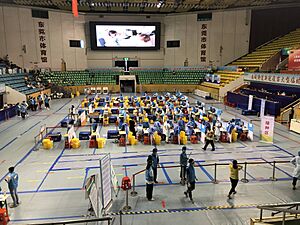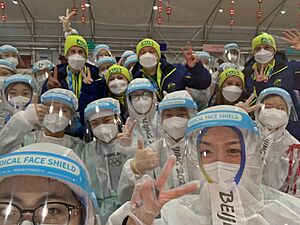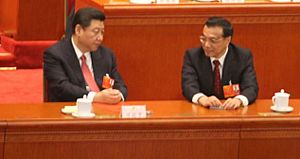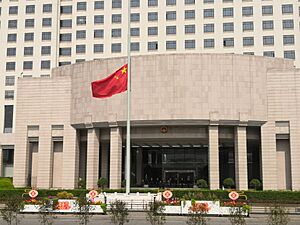Chinese government response to COVID-19 facts for kids
During the COVID-19 pandemic in mainland China, China's government tried a special plan called "zero-COVID." This plan aimed to stop the spread of COVID-19 inside the country. It was led by China's leader, Xi Jinping.
The zero-COVID plan lasted until December 7, 2022. Some people praised it for controlling the virus. Others criticized the government for not being open enough. They also worried about censorship and wrong information. China stopped its zero-COVID policy on December 7, 2022.
The story of COVID-19 in China began in Wuhan, Hubei Province. Doctors found many patients with a strange lung illness. A public notice about this outbreak was shared on December 31, 2019.
Earlier, on December 28, 2019, Chinese scientists had already shared the full genetic code of the virus. They uploaded it to the NIH GenBank. But this report was not made public right away.
On January 8, 2020, Chinese scientists announced a new coronavirus was causing the disease. This virus was named SARS-CoV-2. Two days later, on January 10, a very similar virus's genetic code was shared online.
Later, a report in The Wall Street Journal on January 17, 2024, showed something important. It said that China's government knew about the virus's cause earlier than they had claimed.
On January 23, 2020, the Chinese government stopped travel to and from Wuhan. They started strict lockdowns in affected areas. This was part of a big national effort to fight the virus.
The outbreak in Hubei province was at its worst around February 4, 2020. Large temporary hospitals were quickly built in Wuhan. These hospitals helped separate patients with mild symptoms. The first one opened on February 5, 2020.
Most of the early cases were in Hubei province and Wuhan. By March 22, 2020, over 80% of China's cases were in Hubei. More than 60% of all cases were in Wuhan alone.
By the summer of 2020, China had largely controlled the outbreak. The widespread spread of the virus had mostly stopped. Lockdowns and other strict rules were then eased across China. The lockdown in Wuhan ended on April 8, 2020. It is thought that these controls kept the death toll in Wuhan under 5,000 from January to March 2020.
China was one of the few countries that aimed to completely get rid of the virus. This meant keeping case numbers very low or at zero for a long time. Until late 2022, most new cases in China came from outside the country. Any new outbreaks were quickly stopped. This was done with lots of testing, contact tracing, and mandatory isolation.
In the 18 months after the first outbreak in Wuhan, only two COVID-19 deaths were reported. In December 2022, the Chinese government ended its zero-COVID policy. This happened after protests took place across the country.
In 2020 and 2021, China was a major supplier of medical goods for COVID-19. It was the world's biggest exporter of face masks. Its mask exports grew by about 600% in the first half of 2020.
China also developed several COVID-19 vaccines. These were used in its own vaccination program. They were also sent to other countries as part of vaccine diplomacy. By November 2021, China was the world's largest exporter of COVID-19 vaccines. It had sent out about 40% of all doses worldwide. This was about 1.5 billion doses, according to the World Trade Organization.
China's actions during the initial Wuhan COVID-19 outbreak received both praise and criticism. In October 2020, The Lancet Infectious Diseases said China had controlled the pandemic quickly and well. However, the Chinese government was criticized for censorship. This affected the country's press and Internet.
The government censored whistleblowers, journalists, and social media posts. At the start of the pandemic, the government tried to stop discussions and hide reports. This information was seen as bad for local officials. Efforts to control research into the virus's origins have continued.
Contents
China's Zero-COVID Policy (2020-2022)
China, along with a few other countries, used an "elimination strategy." This was also known as "zero-COVID." The goal was to stop the virus from spreading locally.
This early public health effort was very good at reducing the virus spread. It brought cases inside China almost to zero. In the 18 months after the first outbreak, China had only two COVID-19 deaths.
In March and April 2020, rules were relaxed. The focus then shifted to stopping new cases from abroad. International flights to China were limited. Travelers coming in had to get PCR testing and quarantine. By November 2020, these rules stopped nearly 4,000 infected travelers from spreading the virus.
In June 2020, the China CDC explained its elimination strategy. To control new outbreaks, they used strong methods. These included tracking contacts, isolating infected people, and quarantining close contacts. They also did large-scale testing and limited travel from high-risk areas. Smartphone apps called "health codes" helped with contact tracing.
To find new outbreaks early, regular PCR testing was done. This included testing people with fever or breathing problems. Medical staff and workers handling imported goods were also tested. If an infected person was found, all close contacts had to quarantine for 14 days. They also had many rounds of PCR testing.
During outbreaks, everyone in a community was tested. This helped find infected people, even those without symptoms. Community testing aimed to quickly separate infected people. This also helped life and business return to normal faster. Community testing was first done in Wuhan from May 14 to June 1, 2020. It was used in later outbreaks too.
China's zero-COVID policy also affected the 2022 Winter Olympics and Paralympics in Beijing. Athletes from other countries stayed in a special "bio-secure bubble." This kept them separate from the Chinese public. Only a limited number of local fans could attend.
Beijing had some of the world's strictest COVID rules. Because of this, thousands of people protested against the government. They wanted freedom from constant tests and lockdowns. They also wanted an end to strict censorship and the Communist Party's tight control.
How Many Cases and Deaths?
By 2020, many scientific journals like Science and Nature said China's COVID-19 controls were effective. A study in Science Magazine in March 2020 found something important. The travel ban in Wuhan and the national response might have stopped over 700,000 COVID-19 cases outside the city.
By December 31, 2021, official numbers showed 102,083 total confirmed cases. There were also 4,636 total deaths in mainland China. This means about 3.2 deaths for every million people.
A study in The BMJ found that 4,573 more people died from pneumonia in Wuhan. This was from January to March 2020, compared to the same time in 2019. Outside Wuhan, there was no major increase in pneumonia deaths. Even though there were COVID-19 deaths outside Wuhan, lockdowns might have stopped the flu enough to balance these deaths.
A survey in April 2020 looked for antibodies in people's blood. It found that 4.4% of people in Wuhan had antibodies to SARS-CoV-2. This meant they had been infected. The number of people with antibodies dropped further away from Wuhan. This showed that the first outbreak was mostly contained to the city.
In the rest of Hubei province, 0.4% of people had antibodies. Outside Hubei province, less than 0.1% had them. These results suggest that in the first wave, about 500,000 people were infected in Wuhan. About 210,000 were infected in the rest of Hubei. And about 120,000 were infected outside Hubei.
In November 2020, a British expert named Ben Cowling said something interesting. He noted that China's testing rules meant they found many mild or symptom-free infections. These might not have been found in other parts of the world. This helps explain why China had a relatively low case fatality rate (deaths per case).
A study in May 2022 in Nature predicted what would happen if China lifted its zero-COVID rules. It estimated about 1.5 million deaths. Most of these (74.7%) would be among unvaccinated elderly people (over 60). The need for intensive care units would be 15 times higher than what was available.
On December 23, 2022, China's CDC published its last daily COVID report. It showed zero COVID deaths across China. However, on January 22, 2023, China's CDC said that between January 13 and 19, 2023, 13,000 deaths were reported.
How China's Leaders Responded
On January 20, China's leader Xi Jinping ordered everyone to focus on stopping the epidemic. The Communist Party also promised to guide public opinion. They wanted to make sure society stayed stable. Premier Li Keqiang urged government groups to protect people's health. He told them to stop the virus from spreading. Premier Li also held a meeting with the State Council to plan the response.
On January 21, Premier Li asked for protection for healthcare workers. The National Healthcare Security Administration decided to help pay for treatment for confirmed patients. They also temporarily covered related medicines and medical services. On January 22, Vice Premier Sun Chunlan went to Wuhan to check on the virus control efforts.
On January 26, a special group met to discuss the epidemic. They focused on getting medical staff, protective gear, and masks to Hubei Province and Wuhan. They also made sure daily supplies and relief items reached Hubei. They told local governments to improve virus control. This included canceling events, quarantining sick people, extending the Chinese New Year holiday, and supporting online work and learning. The government promised to stop people from hoarding or overpricing medical supplies. All levels of government would make sure there was enough money for prevention and patient care.
Xi Jinping's Role
On January 27, 2020, Premier Li Keqiang visited Wuhan. He was sent by Xi Jinping to check on the virus control work. Some people were surprised by this. They thought Xi had been taking more power for himself. Some believed Xi might be trying to avoid blame if things went wrong. Li's visit to Wuhan was very popular on Chinese social media.
Xi Jinping said he personally led the fight against COVID-19. He said this when meeting the WHO director general on January 28, 2020. However, a report by The Guardian noted that he didn't appear in public much after that. Social media posts making fun of his absence were quickly removed.
On February 10, 2020, Xi appeared in public for the first time during the outbreak. He visited a neighborhood in Beijing. State media showed photos of Xi wearing a mask. They said he wanted to learn about virus control at the local level. This was his first time meeting people since the outbreak.
On February 15, 2020, a magazine called Qiushi shared something important. It showed that Xi Jinping had given orders about the COVID-19 outbreak on January 7. This was 13 days before the public knew how serious the outbreak was. This raised questions about whether the government was slow to act. Some experts believe Xi might have added this detail later. This could have been because people were angry about the death of Li Wenliang. Li was a doctor who had warned about the virus early on.
On March 10, 2020, Xi Jinping visited Wuhan. This was more than a month after Premier Li Keqiang's visit.
At the 2021 G20 Rome summit, Xi called for more global cooperation on vaccines. He wanted vaccines to be shared fairly. He supported letting other countries use vaccine technology. He also asked developed countries to share vaccine knowledge with developing countries.
In February 2022, Xi worried about a COVID-19 outbreak in Hong Kong. He told officials there to make stopping the virus their main job. In March 2022, during China's biggest outbreak since 2020, Xi said China would stick to its zero-COVID plan. In April 2022, during a lockdown in Shanghai, Xi again praised China's zero-COVID approach. He said it had worked well during the 2022 Winter Olympics.
On May 5, 2022, Xi spoke to top officials about the COVID policy. He said the policy was working. He also asked for a "strong fight against all words and actions that twist, question, or deny our epidemic prevention policies."
National Day of Mourning
On April 3, 2020, the Chinese government announced a national day of mourning. This was for April 4, the Qingming Festival. It was to honor those who died in the COVID-19 pandemic. At 10 a.m., people were asked to be silent for three minutes. Sirens and car horns sounded. Chinese flags were flown at half-mast across the country and at embassies abroad. All public entertainment was stopped for the day.
Food Supply During the Pandemic
During the first outbreak in Wuhan, the government worked to make sure there was enough food. They gave special permits for trucks to bring food from other cities, even during the lockdown.
In May 2022, Premier Li Keqiang told local officials not to let COVID-19 rules stop the harvest. He said that "even if an outbreak is found during the harvest...reaping must go on."
An expert named Darin Friedrichs said that COVID-19 rules caused problems for planting crops in the Northeast. He called it a "delicate balancing act" between making sure there was enough food and keeping zero-COVID rules.
Vaccines and Medicines

In July 2020, the Chinese government allowed emergency use of COVID-19 vaccines. These were made by Sinovac Biotech and China National Biotech Group. They also approved a vaccine from CanSino Biologics for military use. By mid-December, officials said over one million vaccine doses had been given. More than 650,000 people received them, with "no serious bad reactions." Plans were made to vaccinate more people, starting with those at high risk. The vaccine rollout was slow at first because of limited supplies and some people not wanting the vaccine.
In January 2021, Chinese state media raised doubts about the Pfizer–BioNTech COVID-19 vaccine. They asked for an investigation into deaths of elderly people in Norway and Germany after getting the vaccine. Reports suggested they were trying to make Chinese vaccines look safer.
By February 2021, China had sent vaccines to 53 developing countries. Foreign Minister Wang Yi criticized rich countries for keeping too many vaccines. He urged the world to share vaccines fairly.
In April 2021, a European report said Chinese state media focused on possible side effects of Western vaccines. They often ignored other information to make Western vaccines seem unsafe.
In June 2021, China reached one billion doses of its own vaccines given out. This was over one-third of all doses given worldwide at that time. It was about 74 doses for every 100 people. In August 2021, Xi Jinping announced China's vaccine diplomacy goals. He said China would provide 2 billion vaccine doses to other countries by the end of the year.
In August 2022, Pfizer agreed to make Paxlovid in China. In mid-December 2022, after rules were loosened and infections surged, China Meheco Group also agreed to import Paxlovid from Pfizer.
As of February 2023, China was not using any mRNA vaccines. In November 2022, it turned down a deal to import Moderna. In March 2023, China approved its first mRNA vaccine. It was made by a Chinese company, CSPC Pharmaceutical Group.
Help for Other Countries
China sent tests, equipment, experts, and vaccines to other countries. This was to help them fight the pandemic. The European Commissioner for Crisis Management Janez Lenarčič thanked China for its help. Chinese aid was also welcomed in parts of Latin America and Africa. Chinese-Americans also helped get medical supplies from China.
On March 13, China sent medical supplies like masks and respirators to Italy. A team of Chinese medical staff went too. The head of the Italian Red Cross said these supplies were donated. But other sources said they were paid for. Chinese billionaire Jack Ma also donated 500,000 masks and other supplies. These arrived in Belgium on March 13 and were sent to Italy. Italy's Prime Minister Giuseppe Conte thanked China. However, a former Mexican ambassador said that masks sent to China earlier were sold back to Mexico at much higher prices.
A U.S. report in April said that China might choose which countries get medical supplies. This could be based on political reasons.
On May 18, 2020, the Chinese government promised US$2 billion. This money was to help other countries fight COVID-19. It was also for economic and social development, especially in developing countries.
China also gave vaccines to other countries. In November 2021, the Chinese government promised 1 billion vaccine doses to African countries. This included 600 million donated doses and 400 million other doses. This was in addition to the 200 million doses they had already given. In the same announcement, Xi promised more investment in Africa. He also said China would send 1,500 public health experts.
Investigating the Virus Origin
China's government has limited the release of some research about the virus's origins. A rule was made saying that academic papers about the virus's origin must be carefully checked. They had to be approved by a special government group.
An anonymous Chinese researcher said this was an effort by the Chinese government to control the story. They wanted to make it seem like the outbreak did not start in China. The researcher felt this would stop important scientific research. An expert named Yanzhong Huang said it was not surprising that the government wanted to control research. They wanted to make sure findings did not challenge their own story about the virus's origin.
In April 2020, most scientists believed SARS-CoV-2 came from bats. The Chinese government's unwillingness to join investigations has led to other ideas. One idea is the COVID-19 lab leak theory, which is much less likely.




